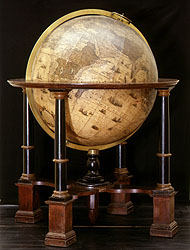 53. Terrestrial globe by J.W. Blaeuw
53. Terrestrial globe by J.W. Blaeuw
Blaeuw’s globes, built in pairs, one terrestrial the other celestial, went through 5 different editions from 1599 to 1638, the year of the author’s death. According to Matteo Fiorini (op. cit.), the Bolognese globes, being without date or dedication, certainly belonged to the post-1622 series - the last series that carried the date - and were also later than 1628, the year a discovery was made on the coasts of New Holland (Western Australia) that is mentioned in one of the inscriptions. It would, therefore, seem reasonable to put the date at somewhere around 1635.
There are 38 strips of paper glued to the terrestrial sphere, i.e. half gores, 20 degrees wide, and two polar circles. Meridians and parallels are drawn every 10 degrees. Equator, tropics, polar circles and ecliptic are marked, as too is the first meridian. Of particular note is the sharpness of the drawings - both the shape of the continents and the many figures populating them: animals, native groups. On the oceans are ships, fish and an intricate allegorical drawing of Neptune on his throne. Compass-cards are also sketched on the oceans, with 32 directions that extend along as many loxodromic lines with the names of the winds in Latin.
A wide array of cartouches record facts, voyages and discoveries. One of these, situated at 50 degrees latitude south, concerns the arbitrary choice of the First meridian which passes through the Canary Islands.
The stand is not original and was probably replaced at the beginning of the XIXth century. In the 1843 inventory we read that the "two old Globes 2 feet in diameter, one celestial and the other terrestrial, the work of G.J. Bleau," are "mounted on newly built wooden feet". Also missing therefore is the strip attached to the globe stand to represent the horizon, usually showing graduations and important dates.
F. Farinelli (1979), p. 186.
M. Fiorini (1989), p. 257.
L. Franco Devetag (1987), p. 86.
L. Luzio (1957), p. 48.
M. Miniati (1991), pp. 96-100.
E.L. Stevenson (1921), pp. 21-44.